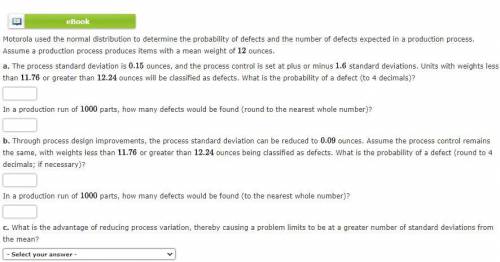
Mathematics, 15.07.2021 23:30 daydallas01
Motorola used the normal distribution to determine the probability of defects and the number of defects expected in a production process. Assume a production process produces items with a mean weight of 12 ounces.
a. The process standard deviation is .15 ounces, and the process control is set at plus or minus 1.6 standard deviations. Units with weights less than 11.76 or greater than 12.24 ounces will be classified as defects. What is the probability of a defect (to 4 decimals)?
In a production run of 1000 parts, how many defects would be found (round to the nearest whole number)?
b. Through process design improvements, the process standard deviation can be reduced to .09 ounces. Assume the process control remains the same, with weights less than 11.76 or greater than 12.24 ounces being classified as defects. What is the probability of a defect (round to 4 decimals; if necessary)?
In a production run of 1000 parts, how many defects would be found (to the nearest whole number)?
c. What is the advantage of reducing process variation, thereby causing a problem limits to be at a greater number of standard deviations from the mean?


Answers: 1
Another question on Mathematics

Mathematics, 21.06.2019 20:00
You wanted to draw an enlargement of design that printed on a card that is 4 in by 5
Answers: 1

Mathematics, 21.06.2019 22:00
Let event a = you roll an even number on the first cube.let event b = you roll a 6 on the second cube.are the events independent or dependent? why?
Answers: 1

Mathematics, 22.06.2019 02:00
Look at this system of equations. -3x + 3y = 12 y = x + 4 the solution set of this system is best explained by which of these statements? a) the graphs of the equations are the same line because the equations have the same slope and the same y-intercept. the system has infinitely many solutions. b) the graphs of the equations are parallel lines because they have the same slope but different y-intercepts. the system has no solution. c) the graphs of the equations are lines that intersect at one point because the equations have the same slope but different y-intercepts. the system has exactly one solution. d) the graphs of the equations are lines that intersect at one point because the equations have the same slope and the same y-intercept. the system has exactly one solution.
Answers: 2

Mathematics, 22.06.2019 02:00
Ven the functions, f(x) = 5x2 - 3x + 1 and g(x) = 2x2 + x - 2, perform the indicated operation. when applicable, state the domain restriction. (f - g)(x) 3x2 - 4x + 3 3x2 - 2x - 1 3x2 - 4x - 1 3x2 - 2x + 3
Answers: 3
You know the right answer?
Motorola used the normal distribution to determine the probability of defects and the number of defe...
Questions


History, 21.03.2020 02:56

Mathematics, 21.03.2020 02:56

Mathematics, 21.03.2020 02:56

Biology, 21.03.2020 02:56




Mathematics, 21.03.2020 02:56

History, 21.03.2020 02:56



Mathematics, 21.03.2020 02:56

Biology, 21.03.2020 02:56


Computers and Technology, 21.03.2020 02:56

Mathematics, 21.03.2020 02:56

Mathematics, 21.03.2020 02:56


Social Studies, 21.03.2020 02:56



